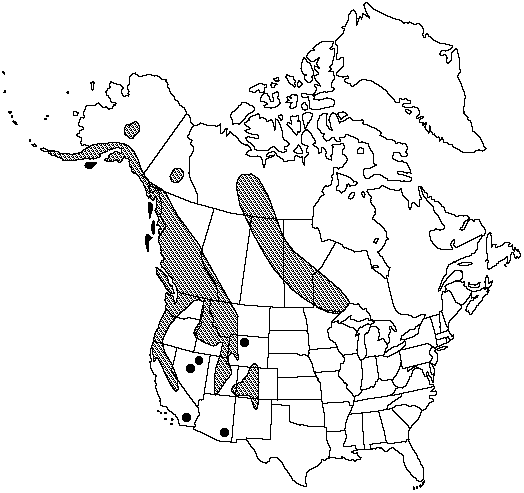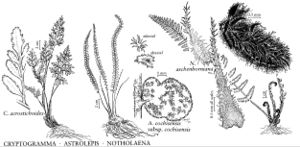Difference between revisions of "Cryptogramma acrostichoides"
in Franklin, Narr. Journey Polar Sea 754, 767. 1823.
FNA>Volume Importer |
imported>Volume Importer |
||
| (7 intermediate revisions by 2 users not shown) | |||
| Line 1: | Line 1: | ||
{{Treatment/ID | {{Treatment/ID | ||
|accepted_name=Cryptogramma acrostichoides | |accepted_name=Cryptogramma acrostichoides | ||
| − | |accepted_authority=R. Brown | + | |accepted_authority=R. Brown |
|publications={{Treatment/Publication | |publications={{Treatment/Publication | ||
| − | |title=in Franklin,Narr. Journey Polar Sea | + | |title=in Franklin, Narr. Journey Polar Sea |
|place=754, 767. 1823 | |place=754, 767. 1823 | ||
|year=1823 | |year=1823 | ||
}} | }} | ||
|common_names=American parsley fern | |common_names=American parsley fern | ||
| + | |special_status={{Treatment/ID/Special_status | ||
| + | |code=F | ||
| + | |label=Illustrated | ||
| + | }} | ||
|basionyms= | |basionyms= | ||
|synonyms={{Treatment/ID/Synonym | |synonyms={{Treatment/ID/Synonym | ||
|name=Cryptogramma crispa subsp. acrostichoides | |name=Cryptogramma crispa subsp. acrostichoides | ||
|authority=(R. Brown) Hultén | |authority=(R. Brown) Hultén | ||
| − | }}{{Treatment/ID/Synonym | + | |rank=subspecies |
| + | }} {{Treatment/ID/Synonym | ||
|name=Cryptogramma crispa var. acrostichoides | |name=Cryptogramma crispa var. acrostichoides | ||
|authority=(R. Brown) C. B. Clarke | |authority=(R. Brown) C. B. Clarke | ||
| + | |rank=variety | ||
}} | }} | ||
|hierarchy=Pteridaceae;Cryptogramma;Cryptogramma acrostichoides | |hierarchy=Pteridaceae;Cryptogramma;Cryptogramma acrostichoides | ||
| Line 23: | Line 29: | ||
}}<!-- | }}<!-- | ||
| − | --><span class="statement" id="st- | + | --><span class="statement" id="st-undefined" data-properties=""><b>Stems </b>decumbent to erect, much branched from base, stout, 10–20 mm diam. (including hardened, persistent leaf bases); scales bicolored, dense, broadly lanceolate to linear, to 6 × 2 mm. <b>Leaves</b> densely tufted, green over winter, persistent after withering; sterile leaves spreading, 3–17 cm; fertile leaves erect, 5–25 cm; hairs small, appressed, cylindric, scattered along grooves of petiole and along costae and costules of adaxial blade surface. <b>Petiole</b> green to straw-colored, dark brown on proximal 1/8 or less, 1–2 mm wide, firm and strawlike, not collapsed; scales bicolored or ± concolored, becoming sparse distally. <b>Blade</b> deltate to ovate-lanceolate, all 2–3-pinnate, somewhat leathery, opaque; hydathodes sunken below leaf surface. <b>Segments</b> of sterile leaves oblong to ovate-lanceolate, bases cuneate, distal 2/3–1/2 of segments crenate to dentate, often somewhat more deeply incised every 2d tooth; segments of fertile leaves horizontal to ascending, strongly differentiated from those of sterile leaves, linear, 3–12 × 1–2 mm; margins of fertile segments revolute, covering sporangia. <b>Sporangia</b> in sori that coalesce at maturity. <b>2n</b> = 60.</span><!-- |
-->{{Treatment/Body | -->{{Treatment/Body | ||
| Line 29: | Line 35: | ||
|elevation=0–3700 m | |elevation=0–3700 m | ||
|distribution=Alta.;B.C.;Man.;N.W.T.;Ont.;Sask.;Yukon;Alaska;Ariz.;Calif.;Colo.;Idaho;Mich.;Mont.;Minn.;Nev.;N.Mex.;Oreg.;Utah;Wash.;Wyo.;reported from Mexico in Baja California;Asia. | |distribution=Alta.;B.C.;Man.;N.W.T.;Ont.;Sask.;Yukon;Alaska;Ariz.;Calif.;Colo.;Idaho;Mich.;Mont.;Minn.;Nev.;N.Mex.;Oreg.;Utah;Wash.;Wyo.;reported from Mexico in Baja California;Asia. | ||
| − | |discussion=<p>Cryptogramma acrostichoides has often been treated as a variety or subspecies of the strictly European Cryptogramma crispa (Linneaus) R. Brown, which has a chromosome number of 2n = 120.</p> | + | |discussion=<p><i>Cryptogramma acrostichoides</i> has often been treated as a variety or subspecies of the strictly European <i>Cryptogramma</i> crispa (Linneaus) R. Brown, which has a chromosome number of 2n = 120.</p> |
|tables= | |tables= | ||
|references= | |references= | ||
| Line 38: | Line 44: | ||
-->{{#Taxon: | -->{{#Taxon: | ||
name=Cryptogramma acrostichoides | name=Cryptogramma acrostichoides | ||
| − | + | |authority=R. Brown | |
| − | |authority=R. Brown | ||
|rank=species | |rank=species | ||
|parent rank=genus | |parent rank=genus | ||
| Line 49: | Line 54: | ||
|distribution=Alta.;B.C.;Man.;N.W.T.;Ont.;Sask.;Yukon;Alaska;Ariz.;Calif.;Colo.;Idaho;Mich.;Mont.;Minn.;Nev.;N.Mex.;Oreg.;Utah;Wash.;Wyo.;reported from Mexico in Baja California;Asia. | |distribution=Alta.;B.C.;Man.;N.W.T.;Ont.;Sask.;Yukon;Alaska;Ariz.;Calif.;Colo.;Idaho;Mich.;Mont.;Minn.;Nev.;N.Mex.;Oreg.;Utah;Wash.;Wyo.;reported from Mexico in Baja California;Asia. | ||
|reference=None | |reference=None | ||
| − | |publication title=in Franklin,Narr. Journey Polar Sea | + | |publication title=in Franklin, Narr. Journey Polar Sea |
|publication year=1823 | |publication year=1823 | ||
| − | |special status= | + | |special status=Illustrated |
| − | |source xml=https:// | + | |source xml=https://bitbucket.org/aafc-mbb/fna-data-curation/src/2e0870ddd59836b60bcf96646a41e87ea5a5943a/coarse_grained_fna_xml/V2/V2_373.xml |
|genus=Cryptogramma | |genus=Cryptogramma | ||
|species=Cryptogramma acrostichoides | |species=Cryptogramma acrostichoides | ||
| − | |||
| − | |||
| − | |||
| − | |||
| − | |||
| − | |||
| − | |||
| − | |||
| − | |||
| − | |||
| − | |||
| − | |||
| − | |||
| − | |||
| − | |||
| − | |||
| − | |||
| − | |||
| − | |||
| − | |||
| − | |||
| − | |||
| − | |||
| − | |||
| − | |||
| − | |||
| − | |||
| − | |||
| − | |||
| − | |||
| − | |||
| − | |||
| − | |||
| − | |||
| − | |||
| − | |||
| − | |||
| − | |||
| − | |||
| − | |||
| − | |||
}}<!-- | }}<!-- | ||
-->[[Category:Treatment]][[Category:Cryptogramma]] | -->[[Category:Treatment]][[Category:Cryptogramma]] | ||
Latest revision as of 21:23, 5 November 2020
Stems decumbent to erect, much branched from base, stout, 10–20 mm diam. (including hardened, persistent leaf bases); scales bicolored, dense, broadly lanceolate to linear, to 6 × 2 mm. Leaves densely tufted, green over winter, persistent after withering; sterile leaves spreading, 3–17 cm; fertile leaves erect, 5–25 cm; hairs small, appressed, cylindric, scattered along grooves of petiole and along costae and costules of adaxial blade surface. Petiole green to straw-colored, dark brown on proximal 1/8 or less, 1–2 mm wide, firm and strawlike, not collapsed; scales bicolored or ± concolored, becoming sparse distally. Blade deltate to ovate-lanceolate, all 2–3-pinnate, somewhat leathery, opaque; hydathodes sunken below leaf surface. Segments of sterile leaves oblong to ovate-lanceolate, bases cuneate, distal 2/3–1/2 of segments crenate to dentate, often somewhat more deeply incised every 2d tooth; segments of fertile leaves horizontal to ascending, strongly differentiated from those of sterile leaves, linear, 3–12 × 1–2 mm; margins of fertile segments revolute, covering sporangia. Sporangia in sori that coalesce at maturity. 2n = 60.
Habitat: New growth produced in spring, spores maturing in summer, sterile leaves green over winter, senescing 2d spring. Noncalcareous cliff crevices, rock outcrops, and talus, often in relatively dry habitats, typically montane but occurring in lowland to alpine habitats
Elevation: 0–3700 m
Distribution

Alta., B.C., Man., N.W.T., Ont., Sask., Yukon, Alaska, Ariz., Calif., Colo., Idaho, Mich., Mont., Minn., Nev., N.Mex., Oreg., Utah, Wash., Wyo., reported from Mexico in Baja California, Asia.
Discussion
Cryptogramma acrostichoides has often been treated as a variety or subspecies of the strictly European Cryptogramma crispa (Linneaus) R. Brown, which has a chromosome number of 2n = 120.
Selected References
None.
